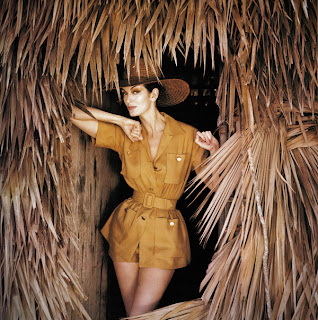Norman Parkinson was, I would have to say, something of a real life wizard. While Beaton was a flamboyant artist through and through, Parkinson was like a magician with an unerring ability to make moments happen.
His beginnings were no more auspicious than Beaton. Raised in suburban Putney there was just about enough money to have him educated at the highly academic Westminster Public School.
There his father hoped he would qualify to be a barrister or an accountant. However, young Parkinson was no scholar, only finding favour with his art master.
Aged just sixteen, Parkinson was already six foot five, and couldn’t help but stand out from the crowd and perhaps as a defence mechanism it encourage the showman in him. He very often featured in his own shoots with his distinctive waxed moustache.
He also happened to adore women and his formative years were full of memories of elegant, glamorous figures swathed in silks and yards of petticoats.
Upon leaving school, his only educational certificate being an art prize, he was apprenticed to the distinguished court photographer Richard Speaight and assisted on royal portrait sessions and debutantes balls. However, he was dismissed having completed only two years of his three year apprentice. His offence was to remove the large bellows camera from it's sturdy tripod and take it up a short studio staircase to demonstrate the virtues of a different and more dynamic angle.
Indeed, Parkinson’s career was going to be very much about getting the camera out of the studio and being mobile. If it took a helicopter to get the shot, he’d get a helicopter. If it took a crane, he’d somehow find a crane.
Anyway, having got the heave ho, he left to set up his own portrait studio in Mayfair shooting the young titled ladies of London town, though he would later lament, the half of them would never pay their bills.
So, the move into fashion photography was a fortuitous one and timely one. Magazines and journals which had previously relied on artists sketches and drawing to illustrate their fashion editorials were now featuring more photography and with that a new medium was being created. For over forty years he would become the first photographer of choice for the fashion editors of the like of Vogue, Harpers Bazar and Queen
What makes Parkinson’s work stand out are the stunning external locations, a striking sense of energy and the ease with which his images serve the outfits he’s photographing.
He always said he was a craftsman, rather than an artist and often displayed a suprising vulnerability. Of the young turks, Bailey, Duffy and Donovan, he styled them ‘the Black Trinity and he quit ‘Queen’ magazine to go freelance when he felt the young new photographer, Tony Snowdon, was snapping at his heels.
Parkinson - Always Something Going On
"My aim was to take moving pictures with a still camera"
His images are invariably full of incident and humour and Parkinson felt that his pictures should always tell a joke, so Wenda Rogerson mimics an Osctrich as she's sits astride one, two Kings Road girls flirt with some London Bobbies and a model in pink dangles from a crane in imitation of the Scales of Justice above the Old Bailey.
Parkinson - Poise & Elegance:
"My art master taught me to see and see quickly, to make composition decisions and stick by them."
Parkinson, at over 6'5", stood rather like an antique lamp post - tall, erect and elegant. So, perhaps not entirely by accident his models were cast very much in that image. Long legged, classical ladies with impish grins in beautiful outfits and brimming with personality and vivacity.
Parkinson - a way with Colour
"I really enjoy colour photography. You can make it a real art by mastering the emulsion and making it your slave."
Parkinson's willingness to harness the demands of colour photography would prove a very astute move and ensure that his work retained a contemporary sheen such that he was never regarded as being of a particular era.
He remained very much in demand and was shooting well into his 70s until suffering a stroke while working on a fashion commission in Singapore.
Hi died soon afterwards but left behind an inspirational archive of work that has been acknowleged as amongst the finest of the last century.




























No comments:
Post a Comment